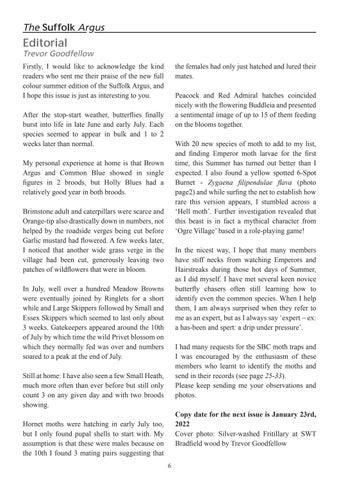The Suffolk Argus
Editorial
Trevor Goodfellow Firstly, I would like to acknowledge the kind readers who sent me their praise of the new full colour summer edition of the Suffolk Argus, and I hope this issue is just as interesting to you.
the females had only just hatched and lured their mates. Peacock and Red Admiral hatches coincided nicely with the flowering Buddleia and presented a sentimental image of up to 15 of them feeding on the blooms together.
After the stop-start weather, butterflies finally burst into life in late June and early July. Each species seemed to appear in bulk and 1 to 2 weeks later than normal.
With 20 new species of moth to add to my list, and finding Emperor moth larvae for the first time, this Summer has turned out better than I expected. I also found a yellow spotted 6-Spot Burnet - Zygaena filipendulae flava (photo page2) and while surfing the net to establish how rare this version appears, I stumbled across a ‘Hell moth’. Further investigation revealed that this beast is in fact a mythical character from ‘Ogre Village’ based in a role-playing game!
My personal experience at home is that Brown Argus and Common Blue showed in single figures in 2 broods, but Holly Blues had a relatively good year in both broods. Brimstone adult and caterpillars were scarce and Orange-tip also drastically down in numbers, not helped by the roadside verges being cut before Garlic mustard had flowered. A few weeks later, I noticed that another wide grass verge in the village had been cut, generously leaving two patches of wildflowers that were in bloom.
In the nicest way, I hope that many members have stiff necks from watching Emperors and Hairstreaks during those hot days of Summer, as I did myself. I have met several keen novice butterfly chasers often still learning how to identify even the common species. When I help them, I am always surprised when they refer to me as an expert, but as I always say ‘expert – ex: a has-been and spert: a drip under pressure’.
In July, well over a hundred Meadow Browns were eventually joined by Ringlets for a short while and Large Skippers followed by Small and Essex Skippers which seemed to last only about 3 weeks. Gatekeepers appeared around the 10th of July by which time the wild Privet blossom on which they normally fed was over and numbers soared to a peak at the end of July.
I had many requests for the SBC moth traps and I was encouraged by the enthusiasm of these members who learnt to identify the moths and send in their records (see page 25-33). Please keep sending me your observations and photos.
Still at home: I have also seen a few Small Heath, much more often than ever before but still only count 3 on any given day and with two broods showing.
Copy date for the next issue is January 23rd, 2022 Cover photo: Silver-washed Fritillary at SWT Bradfield wood by Trevor Goodfellow
Hornet moths were hatching in early July too, but I only found pupal shells to start with. My assumption is that these were males because on the 10th I found 3 mating pairs suggesting that 6



